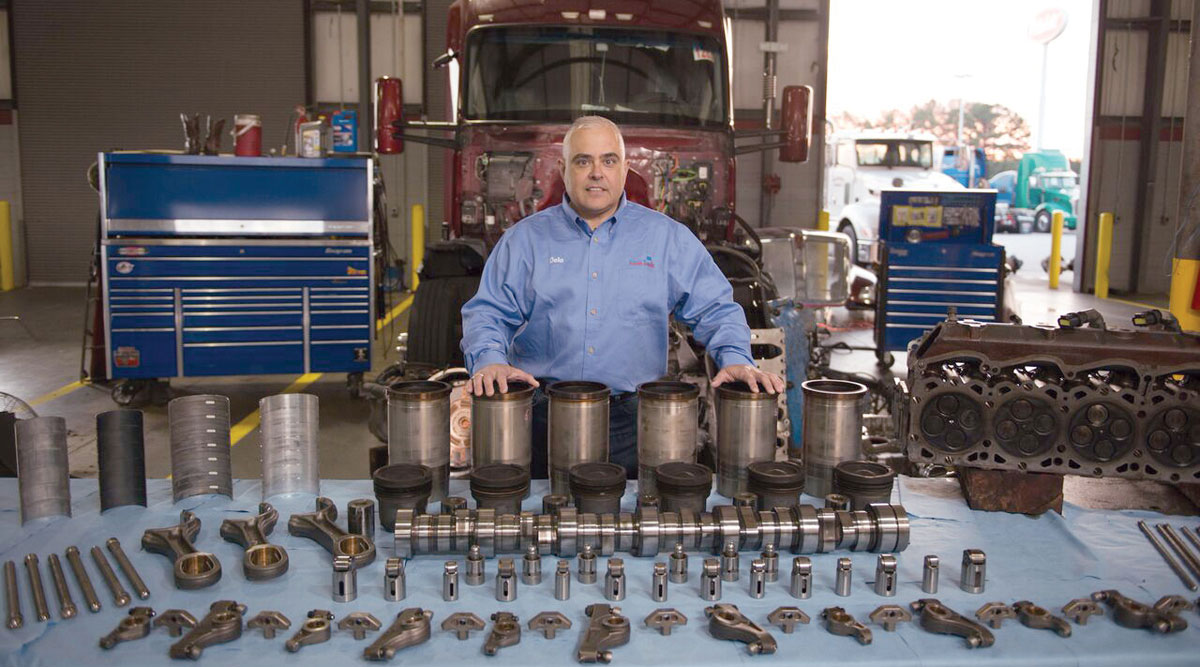CK-4 Oil Makes Headway; Opinions Differ on FA-4

This story appears in the May 15 print edition of Equipment & Maintenance Update, a supplement to Transport Topics.
The American Petroleum Institute has licensed about 400 oil marketers to sell the new CK-4 diesel engine oil since Dec. 1 and more than 60 to sell its slightly lower-viscosity relative, FA-4. These new oils, collectively labeled PC-11 during development and testing, promise fuel savings and, in most applications, longer oil-change intervals.
But acceptance of FA-4 is spotty among engine makers and fleets, especially with downsped engines turning fewer revolutions per minute at cruise. Some suspect engine life and reliability could be compromised while reducing the fuel bill only minimally and complicating lube storage.
Kevin Ferrick, API’s senior manager of global energy services, told Equipment & Maintenance Update in March that the previous heavy-duty engine oil specification, CJ-4, has about 1,000 licensees versus only 400 for CK-4, “so we still have a ways to go.” But CK-4 “is definitely available and eventually will be the dominant product.”
BEST OF MAY E&MU: More stories, columns
FA-4 is a lower-viscosity lube designed to save fuel by reducing friction, especially in what engineers term the “ring-belt area” at the top of the engine’s pistons.
As this publication reported in the June-July 2016 issue, the CJ-4 oil that had been used for about 10 years was set to be replaced by these two new oils. Both have been enhanced to withstand the rigors of lubricating hotter-running diesel engines and boost fuel efficiency better than CJ-4, EMU reported. CJ-4, which is marketed under many brands, was to be phased out of the supply chain after the two new engine oils went on sale Dec. 1.
A few months later, experts tell EMU that the secret to the longer change intervals is more effective engine protection than that provided by CJ-4, even at lower viscosity levels. This is made possible via sophisticated additive technology.
Almost no FA-4 is on shelves yet, Ferrick said. According to the engine manufacturers, this oil is approved only for some of the newest engines. He noted that FA-4 must pass the high-temperature high-shear, or HTHS, requirement designed to test the oil’s ability to reduce friction in that critical ring belt area, where the film of oil is very thin.
Brian Humphrey, technical liaison for Petro-Canada Lubricants, said end users must be aware that FA-4 licensed oils are engineered for newer engines and have “limited backward compatibility” because some older engines are not designed to operate with such low-HTHS viscosity oils.
According to product literature from Valvoline, only the latest engines have slightly more finely polished surfaces on critical parts. These surfaces can tolerate the slightly thinner film of oil produced by FA-4 because of its lower viscosity.
Dan Arcy, OEM technical manager for Shell Lubricants, said the new oils resist acid formation in a significant way.
The API CK-4 and FA-4 oils “are more robust and resistant to oxidation, which is a primary metric for oil life,” said Shawn Whitacre, a senior staff engineer with Chevron and chairman of the American Society of Testing and Materials heavy-duty engine oil classification panel. “These new oils deliver better oxidation stability to meet the needs of hotter-running engines, benefiting not only the new engines but also existing engines that are running at very heavy duty cycles.
“Oils meeting the standard have undergone an engine and bench test protocol that is even more demanding than that required for CJ-4,” Whitacre added.
Engine makers like the new oils, and as a result, most have lengthened change intervals. But there is considerable inconsistency in how they view the especially low-viscosity FA-4.
Both PC-11 oils are noticeably better than CJ-4, said Roger England, an expert on materials science in the areas of fuels and lubrications for engine maker Cummins Inc. But things get more controversial in the use of FA-4.
Engine manufacturers Detroit Diesel, Paccar Inc., Mack Trucks and Volvo Trucks, as well as Navistar International Corp., with its new A-26, have lengthened change intervals based on the use of one or both of the PC-11 oils.
Cummins, the only independent engine supplier, is a special case, having reduced heat stress on the oil in its X15 engine. It has introduced its own oil sampling system, which can allow changes at up to 80,000 miles, even with CJ-4.
Fleets should check each manufacturer’s specifics to make sure oil changes can be extended, experts said.
“Our testing shows FA-4 performs the same as CK-4, and both perform better than CJ-4,” said Greg Braziunas, manager of oil and cooling systems durability at Detroit Diesel. “We encourage all fleets to switch to FA-4 for their EPA10 and later Detroit engines to fully achieve their fuel-economy potential.”
England said all 2017 Cummins engines are approved for FA-4, but “I am not necessarily encouraging its use.” The fuel savings “can be less than 1% in steady-state operation, and in dynamic situations, it may even be less.”
Downspeeding tends to put more mechanical load on the film of oil separating the engine parts.
“If it was my truck, I’d use CK-4 and choose durability over fuel economy,” England said.
However, Jim Nachtman, product manager for International highway trucks at Navistar, said the International A-26 12.4-liter engine is approved to use FA-4 for longhaul transport and regional-haul applications. “FA-4 can be used in all the same oil weights and viscosities as CK-4 oil.”
But Jason Johnson, director of aftermarket at Paccar, said FA-4 “is not approved for use in Paccar engines at this time.”
John Moore, marketing manager, powertrain at Volvo Trucks North America, also said it’s too soon to comment on FA-4 as the oil still is being evaluated.
And at Mack, Scott Barraclough, technology product manager, said, “As of now, Mack is still evaluating FA-4 oils for use in our engines.”
As for a fleet’s perspective, Mike Hasinec, vice president of maintenance support at Penske Truck Leasing, said that Penske is not deploying FA-4 at this time.
“It’s only approved for use in certain engines,” he said. “We’re a diverse fleet and, when it comes to engines, we run every brand under the sun. Our engine oil needs to meet the standards of all the OEMs.”
Penske did extensive testing with five oils and shared information with the engine OEMs, Hasinec said. Testing even included use in some 2007 engines. It collected samples at every drain, a standard practice for the fleet for many years.
“The testing showed FA-4 did not have a negative impact,” Hasinec said, “but we still had some concerns with lubrication at the top end of the cylinder.”
However, Shell’s Arcy reported teardowns at up to 700,000 miles, where the parts from engines using both CK-4 and FA-4 look identical.
Penske is running only CK-4, using a 10W-30 synthetic blend, except in pre-2007 engines, where 15W-40 CK-4 is used. “At this point, CK-4 is doing a good job, and we have no concerns about it,” Hasinec said.
Jeff Torkelson, technical director of engineering tech services at Valvoline, added that the PC-11 standard overall adds a more stringent shear stability requirement. Shear stability means the oil can survive the stresses encountered where close surfaces rub one another at high velocity, according to experts.
“The increased oxidation performance is a direct result of the new Volvo T-13 oxidation test,” Torkelson said. “The new test requires increased levels of antioxidant to pass.”
At a smaller fleet, Bob Maddox, who owns and operates Nick & Dee’s Trucking in Hereford, Texas, with his wife, Dorothy, runs only pre-2007 Cummins engines. “We will continue to use CJ-4 — if it ain’t broke, don’t fix it.”
He has found that switching lubes occasionally may result in minor problems such as leaks.
ExxonMobil’s Paul Cigala, applications engineer for commercial vehicle lubricants, noted not only oxidation stability but better viscosity control and improved aeration control for both the CK-4 and FA-4 oils. These benefits allow the oils “to deliver better overall performance, even over extended drain intervals, compared to previous formulations.”
As for fuel savings, estimates vary, but Arcy said that the average results from Shell’s testing indicate a savings in the range of 1.6% with CK-4 and as much as 4.2% with FA-4.
Nearly all CK-4 oils are approved for use in all the heavy-duty diesels at a 10W-30 viscosity level, in contrast to the traditional, thicker 15W-40 viscosity that was most commonly used in the past.
The lower-viscosity lube still manages full protection because it incorporates more sophisticated anti-wear additives, according to a technical paper from Argonne National Laboratory. These additives mean today’s market price may be affected as much by the viscosity of the oil as by whether it meets the CK-4 or CJ-4 standard.
Meanwhile, Maddox, of Nick & Dee’s Trucking, said he is considering purchasing 2017 equipment soon and may use FA-4 in the engines. “I’ll discuss the choice between CK-4 and FA-4 with the manufacturer,” he said. ³




